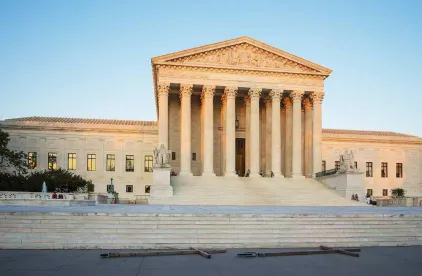On January 13, 2022, the United States Supreme Court granted emergency relief to the petitions of numerous states, businesses, and non-governmental organizations by staying the implementation and enforcement of the federal Occupational Safety and Health Administration’s (“OSHA”) COVID-19 Emergency Temporary Standard (“ETS”). Under the original ETS, private employers with 100 or more employees were required to implement a mandatory vaccination or weekly testing/face covering policy, which constituted a drastic change in policy for many employers and contradicted many state requirements. Although the U.S. Court of Appeals for the Sixth Circuit has yet to ultimately decide on the merits whether the ETS can stand, the stay by the Supreme Court indicates how the Court may ultimately view the ETS and OSHA’s authority to require vaccinations and weekly testing. Nonetheless, the ETS is not dead yet, so employers should continue to monitor the appeal process and OSHA’s response to the stay.
Background on the ETS
As we previously explained in a prior blog, OSHA announced the ETS back on November 4, 2021. Originally, the majority of requirements under the ETS were set to become effective on December 5, 2021, and the mandatory weekly testing policy for unvaccinated workers was set to begin on January 4, 2022. Yet, two days after the ETS announcement, the U.S. Court of Appeals for the Fifth Circuit issued a nationwide stay on the implementation of the ETS. Following the filing of multiple petitions appealing the ETS throughout the country, the Sixth Circuit subsequently “won” the multidistrict lottery to adjudge the validity of the ETS, which included ruling on OSHA’s emergency motion to dissolve the stay. A Sixth Circuit three-judge panel then dissolved the Fifth Circuit’s stay, holding that the ETS was within OSHA’s existing authority and power to regulate viruses and promulgate standards for the health and safety of employees in the workplace in response to “a novel and dangerous worldwide pandemic.”
Following the Sixth Circuit’s decision, OSHA announced that the original deadlines under the ETS remained in effect, including the original deadline for requirements that became effective on December 5, 2021. OSHA announced, however, that it would not enforce the non-testing requirements under the ETS until January 10, 2022, and would not enforce the testing mandate until February 9, 2022. In the interim, numerous petitioners sought review of the Sixth Circuit’s decision. In a relatively unprecedented hearing on emergency relief, the Supreme Court heard over two hours of arguments on January 7, 2022.
The Supreme Court Held OSHA Does Not Have the Authority for Such a Broad ETS
On January 13, 2022, the Supreme Court granted the request for a stay of OSHA’s ability to implement and enforce the ETS. As a result, employers under OSHA’s jurisdiction throughout the country are no longer required to adhere to the federal COVID-19 ETS requirements as of January 13, 2022. The Court’s decision is significant because the Court only granted the stay after determining that the petitioners were likely to win on the merits. In other words, if the Supreme Court thought it was a close call, it would not have granted the stay.
Thus, the Court’s decision on the stay of the ETS effectively operated as a mini-hearing on the legitimacy of the ETS. In granting the stay, the Court instructed that the “[a]pplicants are likely to succeed on the merits of their claim that the Secretary [of Labor] lacked authority to impose the mandate.” Although the Sixth Circuit has yet to assess the merits of the ETS, the Supreme Court’s decision makes OSHA’s position an uphill battle.
Basis for the Supreme Court’s Decision
The majority based its decision on the following arguments:
-
Generally, OSHA’s regulations must be “reasonably necessary or appropriate to provide safe and healthy employment” and be developed using a rigorous process with time for notice and comment and a public hearing. The OSH Act allows for an ETS as an exception to the ordinary procedures. Briefly put, a valid ETS requires (1) a grave danger to employees from an agent that is a toxic substance, physically harmful, or a new hazard, and (2) that the emergency regulation is “necessary.”
-
Quoting the recent case, Alabama Assn. of Realtors v. Dep’t of Health and Human Servs, the majority explained in its decision that a federal agency’s authority comes from a clear expression from Congress. The Court reasoned that although OSHA can regulate a “workplace safety standard,” the ETS reaches beyond that and ventures into the territory of broad public health measures, a realm beyond OSHA’s grasp. Consequently, the ETS would be a “significant encroachment into the lives—and health—of a vast number of employees.”
-
Although COVID-19 has the potential to affect all employees, it is not an “occupational hazard” or grave danger that inherently stems from the workplace. The Court explained that COVID-19 is a universal risk capable of spreading anywhere people congregate and likened its risk to that of “day-to-day dangers that all face from crime, air pollution, or any number of communicable diseases.” Allowing OSHA to regulate so expansively because COVID-19 happens to affect the workplace would allow an unjust expansion of OSHA’s authority. Unlike other universal dangers that OSHA can regulate, such as fire or sanitation, a vaccine mandate would escape the confines of the workplace as employees cannot choose to become unvaccinated for the purposes of heading home after work.
-
The Court recognized that OSHA does have the power to regulate specific occupational risks associated with COVID-19. For example, OSHA would have authority when a particular function of a job would place employees in a special danger (e.g., researchers who work with the COVID–19 virus, or broader regulations regarding particularly crowded or cramped environments). However, the ETS’ application to all industries in such a broad swath exceeded the specificity required to distinguish between a general public health measure and an “occupational safety or health standard.”
-
Finally, the Court noted OSHA lacked any historical precedent for such a broad ETS. Of the nine previous ETS issued by OSHA, none have been as broad, six were challenged, and only one was fully upheld.
Next Steps for Employers
As noted above, the Sixth Circuit has yet to rule on the ETS on the merits. However, even if the Sixth Circuit determines that the ETS may stand, it seems unlikely that the Supreme Court will decide differently on a subsequent appeal on the merits, given that the arguments for and against the stay are likely no different than the arguments the Court already heard. Moreover, in order for the Supreme Court to reach its decision, it needed to determine that the petitioners were “likely to succeed on the merits of their claim that the Secretary [of Labor] lacked authority to impose the mandate a stay.”
On OSHA’s website, the Secretary of Labor issued a statement that he believes the ETS was properly promulgated under the authority granted by Congress and OSHA will evaluate all options to ensure worker safety and “do everything in its existing authority to hold businesses accountable for protecting workers.” Generally, an ETS may only exist for six months and must be replaced by a permanent standard to remain in effect thereafter. Thus, OSHA may choose to modify the standard to only cover certain industries and ultimately issue a permanent standard instead. The permanent standard would also lower the threshold for the standard from “necessary” to “reasonably necessary or appropriate.” Therefore, a modified version of the ETS may be in front of the Supreme Court once again after that process is completed.
In the interim, employers should continue to make preparations to comply with the ETS in the unlikely event it is upheld by both the Sixth Circuit and the Supreme Court. Additionally, state and local regulations on COVID-19 are constantly changing, so employers should continue to keep up to date with both state and local requirements.
The legal landscape continues to evolve quickly and there is a lack of clear-cut authority or bright line rules on implementation. This article is not intended to be an unequivocal, one-size-fits-all guidance, but instead represents our interpretation of where applicable law currently and generally stands. This article does not address the potential impacts of the numerous other local, state and federal orders that have been issued in response to the COVID-19 pandemic, including, without limitation, potential liability should an employee become ill, requirements regarding family leave, sick pay and other issues.





 />i
/>i

